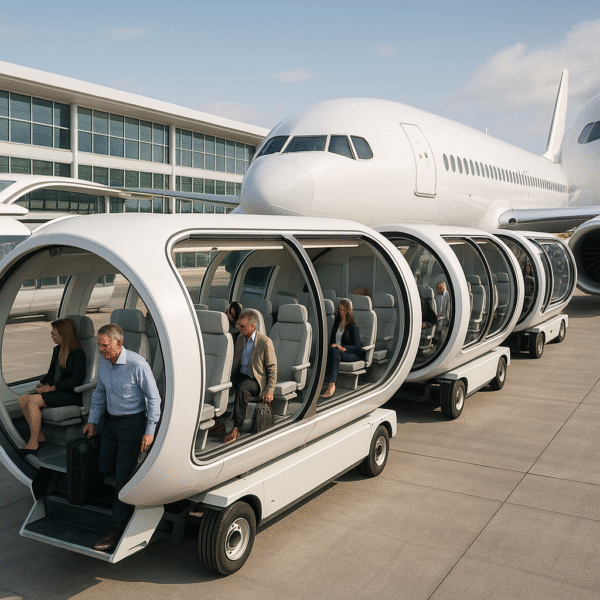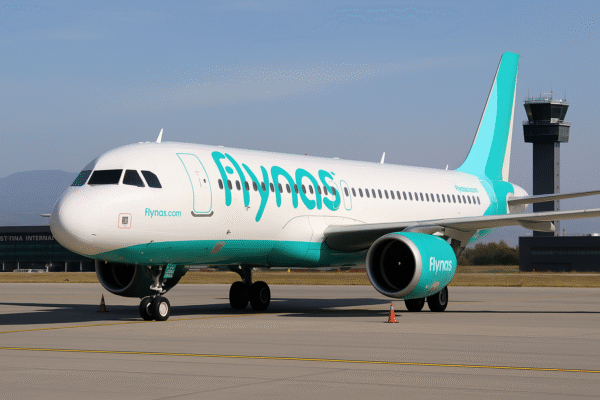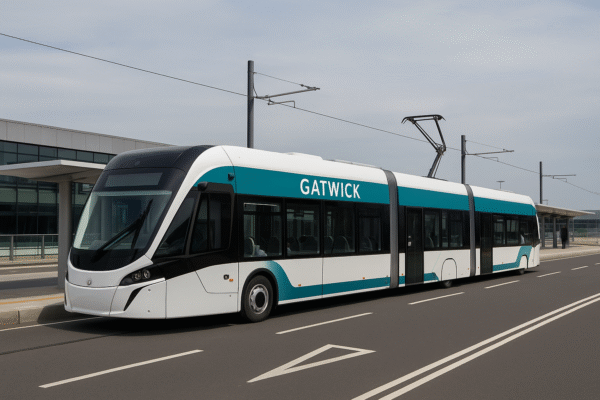London Gatwick Airport is fast-tracking its journey to become one of the greenest major air travel hubs in the world. As part of a £14 million investment into sustainable infrastructure, the airport has announced plans to replace its current diesel-powered Park & Ride shuttle buses with a fleet of futuristic 18-metre-long electric trams. These state-of-the-art vehicles are scheduled to be operational by Christmas 2025, marking a significant step in Gatwick’s broader decarbonisation strategy.
The transition is not only about modernising passenger transport — it is a critical component of Gatwick’s wider £250 million sustainability programme aimed at achieving net-zero carbon emissions by 2030. With over 43 million passengers recorded last year, many of whom rely on Park & Ride services, the new electric fleet is expected to drastically improve energy efficiency, passenger experience, and environmental impact.
A New Era in Green Airside Transport
The electric trams, developed in partnership with Irish e-mobility specialists, are equipped with cutting-edge Irizar battery technology. Each tram will benefit from an ultra-fast pantograph charging system capable of fully recharging the vehicle in just six minutes at dedicated tram stations. The fleet of 14 electric trams will eliminate an estimated 17.7 tonnes of carbon emissions annually, directly contributing to Gatwick’s target to become a carbon-neutral operation in the near future.
Unlike the traditional shuttle buses, these sleek trams will feature high-capacity luggage racks, enhanced digital vision cameras for improved safety, and advanced driver assistance systems that reduce blind spots — all while offering a smoother, quieter ride.
Passenger Comfort Meets Climate Responsibility
Sustainability is central to Gatwick’s “Decade of Change” programme, but so is passenger satisfaction. According to Stewart Wingate, CEO of London Gatwick, the transition to electric vehicles will enhance both comfort and convenience for the millions who rely on Park & Ride services annually.
“These trams are not just a green alternative — they reflect the future of airport mobility. We’re creating a model for others to follow,” said Wingate.
Passengers travelling between long-stay car parks and terminals will enjoy a more seamless and environmentally friendly journey, without the emissions or noise pollution associated with diesel buses.
A Blueprint for Aviation Sustainability
This initiative is one of several steps Gatwick is taking toward full fleet electrification. The airport has already introduced 47 new electric airside vehicles for use in baggage handling, engineering support, and ground operations. These advancements form part of a holistic approach to emissions reduction that includes sourcing 100% renewable electricity, expanding solar panel usage, and investing in energy-efficient building technologies.
In line with recommendations by the UK Civil Aviation Authority and international climate goals, Gatwick’s long-term ambition is to become a role model for sustainability in aviation — a sector under increasing pressure to limit its environmental footprint.
Global Context: A Wider Push for Green Airports
The UK’s second-largest airport isn’t alone in its green ambitions. Across Europe and the world, airport authorities are racing to adopt carbon-neutral strategies. Heathrow has announced similar goals, while Amsterdam’s Schiphol and Oslo Airport have implemented sustainable ground transport systems using electric buses and biofuel-powered equipment.
The UK Department for Transport (DfT) has also laid out its “Jet Zero” strategy, aiming to decarbonise domestic aviation by 2040. Gatwick’s tram project aligns with this national framework and supports the government’s broader goals outlined in the Transport Decarbonisation Plan (2021), which encourages innovation in airport ground operations.
Economic and Environmental Benefits
By transitioning to electric trams, Gatwick expects not just a cleaner carbon profile but also reduced operational costs in the long run. Electric vehicles are cheaper to maintain than their diesel counterparts and contribute less to local air pollution — a critical concern for communities surrounding the airport.
Furthermore, the visible sustainability measures enhance Gatwick’s global reputation as an eco-conscious travel hub, potentially attracting environmentally aware travellers and airline partners looking to align with green initiatives.
What’s Next: Continued Innovation Ahead of 2030
Looking beyond 2025, Gatwick has signalled that further investments in smart mobility and clean technologies are on the horizon. Collaborations with sustainable engineering firms, AI-powered traffic management systems, and expanded electric charging infrastructure are all being explored.
The airport is also participating in wider industry discussions on sustainable aviation fuel (SAF), hydrogen propulsion research, and partnerships with low-emission aircraft manufacturers.
“This transformation goes beyond ground transport — it’s about reimagining what a sustainable airport can look like by 2030,” said Rachel Thompson, Sustainability Director at Gatwick Airport.
Conclusion
Gatwick Airport’s £14 million investment in a new electric tram fleet marks a milestone in the airport’s ambitious plan to lead the aviation industry into a low-emission future. By prioritising both passenger experience and environmental responsibility, Gatwick is setting a new benchmark for UK airports and demonstrating that sustainable travel begins long before passengers step onto a plane.
As global aviation faces increasing scrutiny over its carbon footprint, initiatives like these show that meaningful progress is possible — and that major transport hubs can lead the charge toward a cleaner, more responsible future in travel.
For more travel news like this, keep reading Global Travel Wire






















